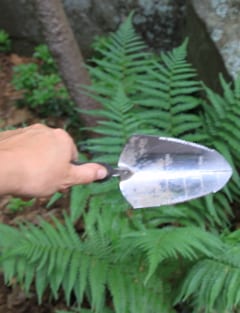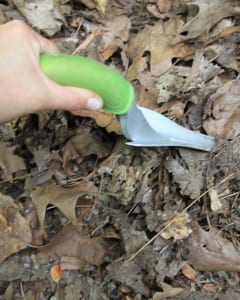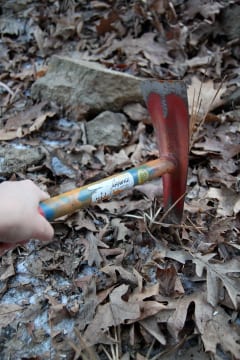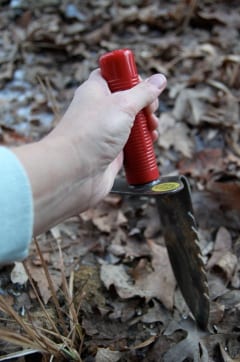by New Moon Nursery
New Moon Nursery has specialized in growing native perennials, grasses, rushes, sedges and vines in ‘Deep Plug’ trays since we started in 2003. This means the plants arrive to the job site in cells 2.5” in diameter and 4.5” deep. While there are a lot of advantages to the Deep Plugs, including more root mass and a more quickly established plant, these larger plugs also mean larger holes that have to be dug.
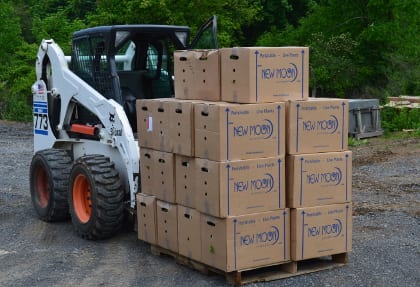
New Moon delivery of native perennial plugs to Elijah Evans Excavating in Danville, PA destined for a large residential landscape installation. Photo by Elijah Evans
It can be daunting looking at tray after tray of 50 plants stacked up just waiting to be planted at a job site. You have all of these plugs, they look great, the job is going to look great…eventually. But how best to get these plants in the ground? “How do I plant these?” is probably one of our most frequently asked questions. Because we are a small, family-run nursery in Southern NJ, we often hear these questions directly from our customers. With more than 1.5 million plants propagated annually, we decided we should probably come up with an educated answer to this frequent question. We decided to test some of the tools out there to see what worked best for us, and so we could give some advice to our buyers.
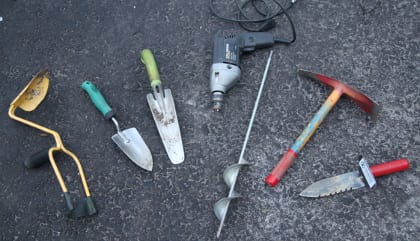
Testing Situations
We tested six tools on two job sites. First was a large scale planting in a former farm field. The homeowners and landscape professionals installed more than 3000 plugs suitable for a sunny upland meadow planting using a variety of tools. For the second experiment, homeowners in a woodland residential situation with very clayey, rocky soils tested the tools. Though the plants were different, we grow plants suitable for nearly any growing condition you may have from woodlands to wetlands, the tools used were the same.
Good Old Fashioned Trowel
- Readily available at any hardware store/ garden center
- Everyone knows what it is and how to use it.
- Correct size hole for plugs.
- Plenty of soil for refilling holes.
Cons:
After about 20 holes… you’re over it. It is not very efficient.
Tips:
Use it backwards. Stab the trowel into the ground and pull it towards you for a more comfortable feel and ease of use.
Recommendation: Have this on stand-by. It is not the best, not the worst and will work great in a pinch!
Ergonomic Handled Trowel
Slightly easier on the wrist than a traditional trowel.
Cons:
- Not as readily available
- Wrist still tired after a tray or two.
- Ergonomic handle makes leverage tough in clay or hard soils.
- Still nose to nose with plugs while planting them. (Tough on the taller among us)
Tips: Because of the handle there’s really only one way to use this trowel. Was probably the least favorite tool of all tested on site.
Recommendation: Okay for a flat or two, but if you are planting plugs in the thousands (which we hope you are) best switch to a different tool.
Auger Bit and Electric Drill
- Quick – you can make 50 holes in no time!
- Above the ground – you don’t have to get up close and personal with each hole as you dig it.
Cons:
- Electric cords everywhere. Sure you could go the gas-powered route.
- Soil is sprayed everywhere not leaving much to put back in the hole.
- Side of hole is sheared in clayey soils, meaning it is glassy smooth, never a good thing when planting plants. The hole then is not really much different that the sides of a plastic pot, difficult for roots to penetrate.
Tips:
Slower operation may be better to keep refilling soil nearby!
Recommendation: Hard to deny the appeal of more power! If you have the electric onsite and well-trained staff to plant without wasting soil, then this may be the tool for you. Planting holes may still need to be roughed up before plug planting.
Feather-Weight Mini Pick
- Great angle for digging lots of holes
- Pick helps get through rocky or clayey soils
- Trowel end creates holes perfectly sized for plugs
- Lightweight, easy to use all day
- Made in the USA from the American Garden Tool Company
- Though lightweight, seems indestructible
Cons:
Many of these tools available in the trade are heavy – though the weight is good for creating holes with little effort. Doing this a thousand times will certainly build your forearms!
Tips:
Have a lot of these on hand – these were fought over at the job site. The model shown above was certainly a great forearm workout!
Recommendation: Pack lots of these in the equipment truck! Easily used by everyone, tough enough to do lots of jobs. Great multi-tool that will work in a variety of soil types and conditions.
The Bionic Trowel (Easy-grip Garden Trowel)
- Comfortable and easy to use
- Creates the perfect planting hole with easy motion
- Little wrist stress
- Wrist extension means you don’t have to get as low to the ground to plant the holes.
Cons:
- Hard to find one for sale
- Have to have perfectly prepared garden soil to work well
- Because of handle set-up can’t rotate tool to get rocks or roots out of the way
Tips:
People with thinner forearms seemed a little more uncomfortable using this than those whose forearms filled out the brace completely.
Recommendation: If you are dealing with perfectly prepared loamy garden soil, this is the tool to use! Fatigue was less and it was fairly comfortable. In any other situation, leave this at the shop.
Lesche Digging Tool
Pros:
- Lightweight
- Serves multiple purposes
- Works in multiple soil types and conditions
- Small and compact, convenient sheath goes right on your belt
- Serrated edge creates rough holes perfect for planting
- Size is the right size for planting plugs
- Upright handle keeps wrist in a comfortable position
- Fairly indestructible tool
- Made in the USA from the American Garden Tool Company
Cons:
- Only good for plug sized plants. Bigger holes would take forever.
- Once again you are nose-to-nose with plugs.
Tips:
Start by stabbing the blade into the ground where the plug will grow, pull the knife towards you and a hole is created. If you run into a rock or roots, turn the knife over to excavate the hole and then plant.
Recommendations: This and the feather-weight mini pick were the tools most fought over. This useful tool should be in everyone’s tool belt.
So as with any job, the tool you choose will depend on the site conditions and the people using the tools. We are not sure there is one answer for planting plugs, but there are certainly options available for most of the people who will be planting and most soil conditions you will run into. Doing this research is just part of the fun we have operating this business, propagating these plants for distribution all along the Eastern Seaboard and the Midwest. We are thrilled these native plants are getting planted. When we started this nursery a dozen years ago, we focused on natives because they are beautiful, they offer benefit to the native animals around and because they belong.
About the Author
Located in Southern NJ and operated by James and Kim Brown, New Moon Nursery is a wholesale grower of herbaceous perennials, grasses, vines, and ferns. Our focus on plug production of native plants allows us to dedicate time, energy, resources and knowledge to growing specific plant lines for our customers. More than 25 years of experience translates into superior plants and better prepares us to respond to our clients’ regional and project requirements. Enrich your world with Eastern native species, for a wide range of site conditions and ecosystems. Find us at newmoonnursery.com.

